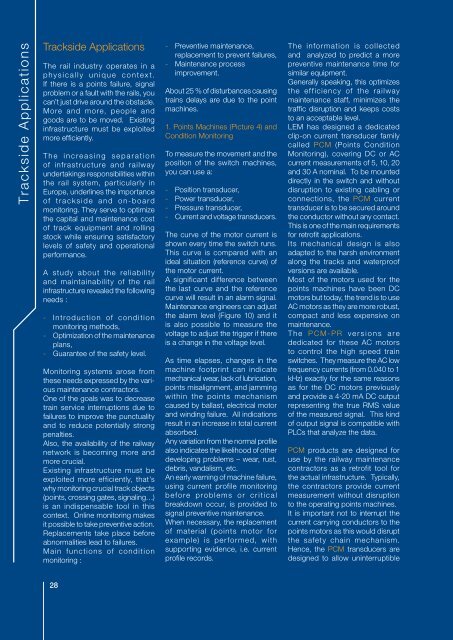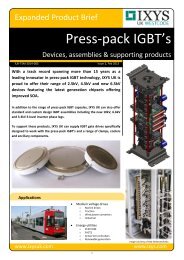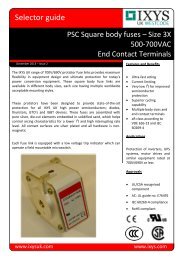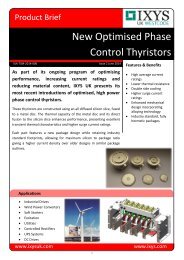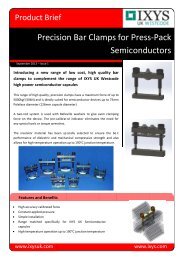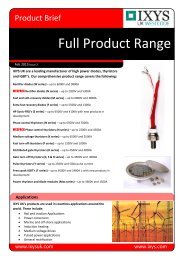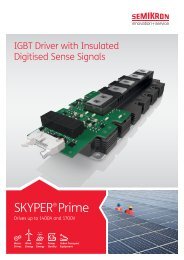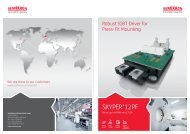railway current voltage transducers
Create successful ePaper yourself
Turn your PDF publications into a flip-book with our unique Google optimized e-Paper software.
Trackside Applications<br />
Trackside Applications<br />
The rail industry operates in a<br />
physically unique context.<br />
If there is a points failure, signal<br />
problem or a fault with the rails, you<br />
can’t just drive around the obstacle.<br />
More and more, people and<br />
goods are to be moved. Existing<br />
infrastructure must be exploited<br />
more efficiently.<br />
The increasing separation<br />
of infrastructure and <strong>railway</strong><br />
undertakings responsibilities within<br />
the rail system, particularly in<br />
Europe, underlines the importance<br />
of trackside and on-board<br />
monitoring. They serve to optimize<br />
the capital and maintenance cost<br />
of track equipment and rolling<br />
stock while ensuring satisfactory<br />
levels of safety and operational<br />
performance.<br />
A study about the reliability<br />
and maintainability of the rail<br />
infrastructure revealed the following<br />
needs :<br />
- Introduction of condition<br />
monitoring methods,<br />
- Optimization of the maintenance<br />
plans,<br />
- Guarantee of the safety level.<br />
Monitoring systems arose from<br />
these needs expressed by the various<br />
maintenance contractors.<br />
One of the goals was to decrease<br />
train service interruptions due to<br />
failures to improve the punctuality<br />
and to reduce potentially strong<br />
penalties.<br />
Also, the availability of the <strong>railway</strong><br />
network is becoming more and<br />
more crucial.<br />
Existing infrastructure must be<br />
exploited more efficiently, that’s<br />
why monitoring crucial track objects<br />
(points, crossing gates, signaling…)<br />
is an indispensable tool in this<br />
context. Online monitoring makes<br />
it possible to take preventive action.<br />
Replacements take place before<br />
abnormalities lead to failures.<br />
Main functions of condition<br />
monitoring :<br />
- Preventive maintenance,<br />
replacement to prevent failures,<br />
- Maintenance process<br />
improvement.<br />
About 25 % of disturbances causing<br />
trains delays are due to the point<br />
machines.<br />
1. Points Machines (Picture 4) and<br />
Condition Monitoring<br />
To measure the movement and the<br />
position of the switch machines,<br />
you can use a:<br />
- Position transducer,<br />
- Power transducer,<br />
- Pressure transducer,<br />
- Current and <strong>voltage</strong> <strong>transducers</strong>.<br />
The curve of the motor <strong>current</strong> is<br />
shown every time the switch runs.<br />
This curve is compared with an<br />
ideal situation (reference curve) of<br />
the motor <strong>current</strong>.<br />
A significant difference between<br />
the last curve and the reference<br />
curve will result in an alarm signal.<br />
Maintenance engineers can adjust<br />
the alarm level (Figure 10) and it<br />
is also possible to measure the<br />
<strong>voltage</strong> to adjust the trigger if there<br />
is a change in the <strong>voltage</strong> level.<br />
As time elapses, changes in the<br />
machine footprint can indicate<br />
mechanical wear, lack of lubrication,<br />
points misalignment, and jamming<br />
within the points mechanism<br />
caused by ballast, electrical motor<br />
and winding failure. All indications<br />
result in an increase in total <strong>current</strong><br />
absorbed.<br />
Any variation from the normal profile<br />
also indicates the likelihood of other<br />
developing problems – wear, rust,<br />
debris, vandalism, etc.<br />
An early warning of machine failure,<br />
using <strong>current</strong> profile monitoring<br />
before problems or critical<br />
breakdown occur, is provided to<br />
signal preventive maintenance.<br />
When necessary, the replacement<br />
of material (points motor for<br />
example) is performed, with<br />
supporting evidence, i.e. <strong>current</strong><br />
profile records.<br />
The information is collected<br />
and analyzed to predict a more<br />
preventive maintenance time for<br />
similar equipment.<br />
Generally speaking, this optimizes<br />
the efficiency of the <strong>railway</strong><br />
maintenance staff, minimizes the<br />
traffic disruption and keeps costs<br />
to an acceptable level.<br />
LEM has designed a dedicated<br />
clip-on <strong>current</strong> transducer family<br />
called PCM (Points Condition<br />
Monitoring), covering DC or AC<br />
<strong>current</strong> measurements of 5, 10, 20<br />
and 30 A nominal. To be mounted<br />
directly in the switch and without<br />
disruption to existing cabling or<br />
connections, the PCM <strong>current</strong><br />
transducer is to be secured around<br />
the conductor without any contact.<br />
This is one of the main requirements<br />
for retrofit applications.<br />
Its mechanical design is also<br />
adapted to the harsh environment<br />
along the tracks and waterproof<br />
versions are available.<br />
Most of the motors used for the<br />
points machines have been DC<br />
motors but today, the trend is to use<br />
AC motors as they are more robust,<br />
compact and less expensive on<br />
maintenance.<br />
The PCM-PR versions are<br />
dedicated for these AC motors<br />
to control the high speed train<br />
switches. They measure the AC low<br />
frequency <strong>current</strong>s (from 0.040 to 1<br />
kHz) exactly for the same reasons<br />
as for the DC motors previously<br />
and provide a 4-20 mA DC output<br />
representing the true RMS value<br />
of the measured signal. This kind<br />
of output signal is compatible with<br />
PLCs that analyze the data.<br />
PCM products are designed for<br />
use by the <strong>railway</strong> maintenance<br />
contractors as a retrofit tool for<br />
the actual infrastructure. Typically,<br />
the contractors provide <strong>current</strong><br />
measurement without disruption<br />
to the operating points machines.<br />
It is important not to interrupt the<br />
<strong>current</strong> carrying conductors to the<br />
points motors as this would disrupt<br />
the safety chain mechanism.<br />
Hence, the PCM <strong>transducers</strong> are<br />
designed to allow uninterruptible<br />
connection and measurement by<br />
way of the clip-on package. This<br />
type of retrofit is a requirement by<br />
the integrators and infrastructure<br />
owners.<br />
Of course, condition monitoring<br />
using <strong>transducers</strong> may be<br />
integrated into the initial design<br />
of the points machine system. If<br />
this is the case, electrical <strong>current</strong><br />
interruption is not a concern<br />
and therefore other, more cost<br />
effective, <strong>current</strong> measurements<br />
are available. Being part of the<br />
original electronic assembly, PCB<br />
mounted <strong>current</strong> <strong>transducers</strong><br />
might be viable solutions. LEM<br />
can offer the LTS 6-15-25-NP or<br />
the LA 25-NP or CAS/CASR/CKSR<br />
6-15-25-50-NP series <strong>transducers</strong><br />
for this particular application.<br />
2. Track Circuits (Picture 5) and<br />
Condition Monitoring<br />
About 5 % of disturbances causing<br />
trains delays are due to track<br />
circuit failures. The track circuit is a<br />
method of indicating the presence<br />
of a train on a given section of line.<br />
With relay-operated signals, the<br />
extend of the circuit typically<br />
corresponds to a signaling block<br />
section.<br />
Picture 4: Points Machine along the tracks.<br />
Figure 10: Typical <strong>current</strong> profile of a points DC Motor over the time<br />
Picture provided by courtesy of STRUKTON<br />
PCM FAMILY<br />
5 to 30 A<br />
Clip-on design - Ideal for retrofit applications<br />
CASR FAMILY<br />
6 - 15 - 25 - 50 A<br />
LTS FAMILY<br />
6 - 15 - 25 A<br />
LA 25-NP FAMILY<br />
0.25 to 25 A<br />
Trackside Applications<br />
PCB mounted <strong>current</strong> <strong>transducers</strong><br />
28<br />
29


